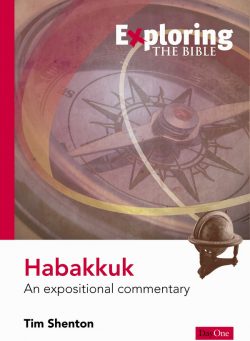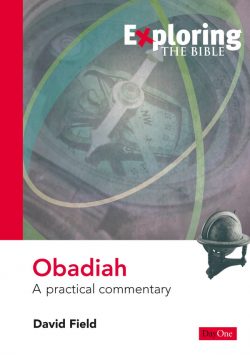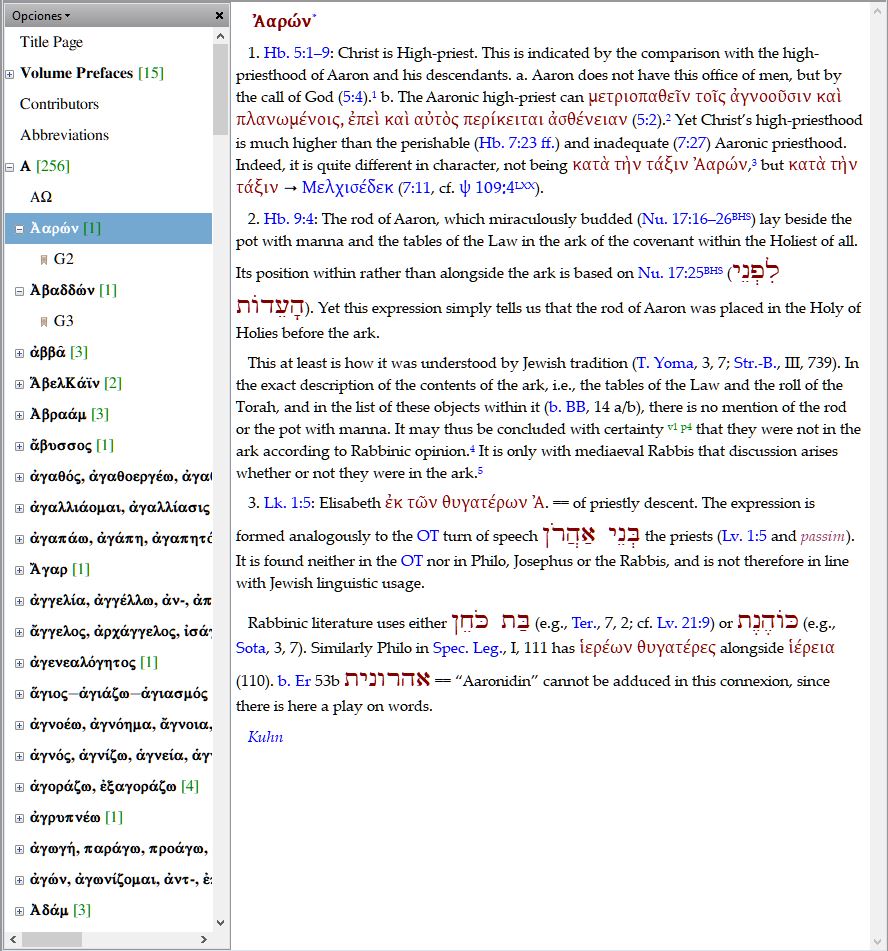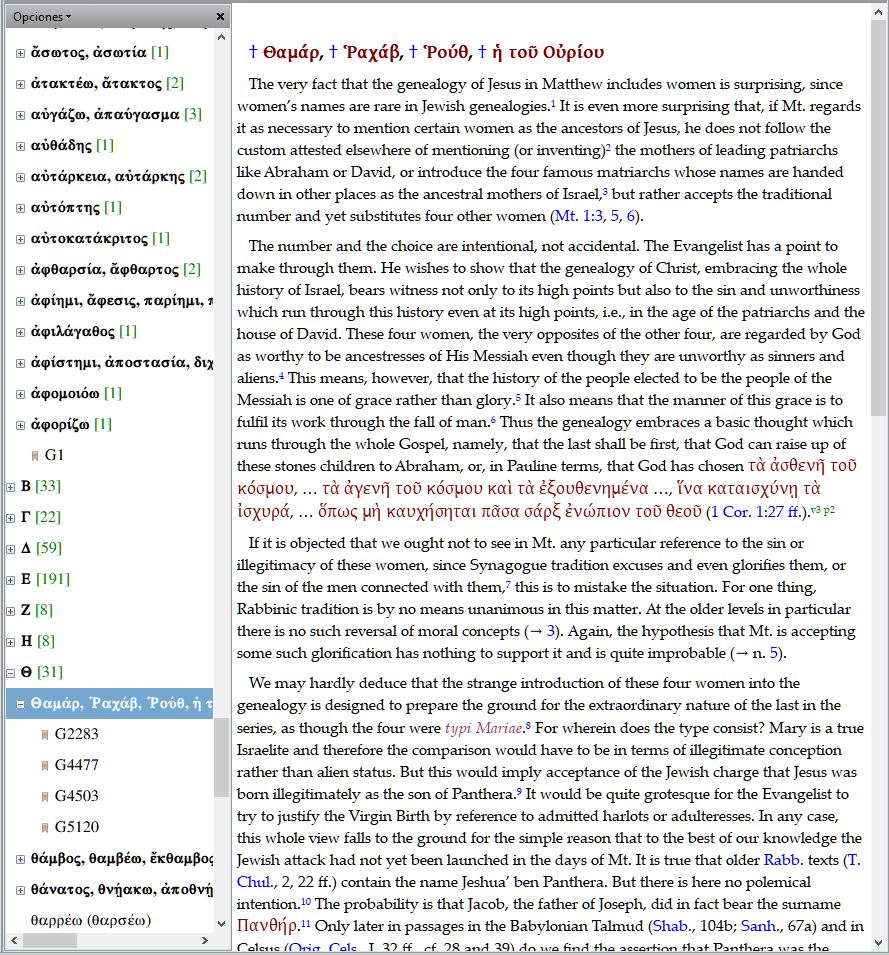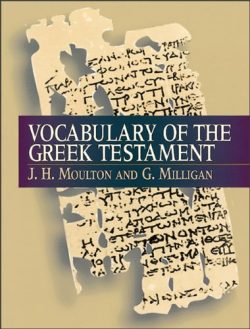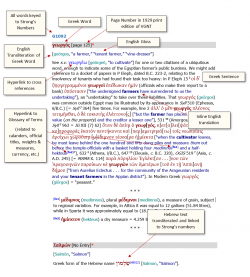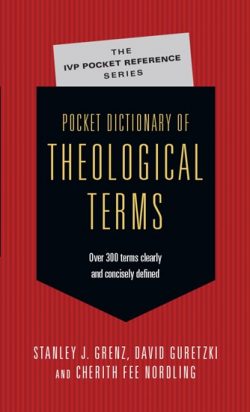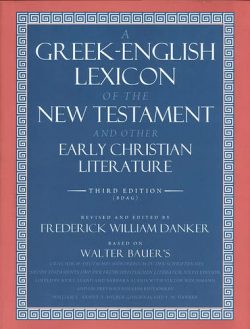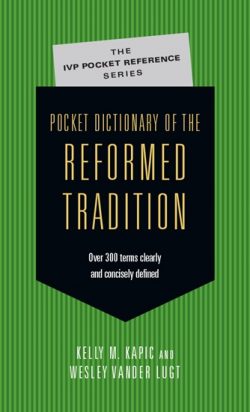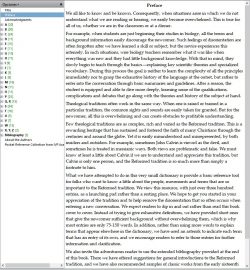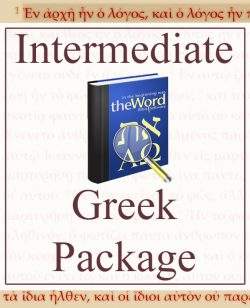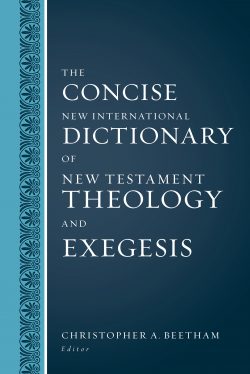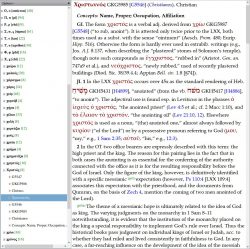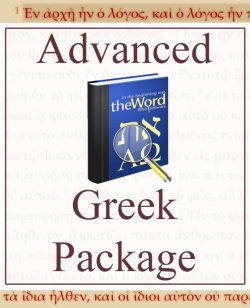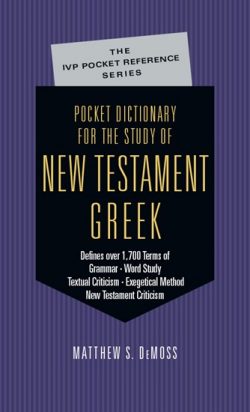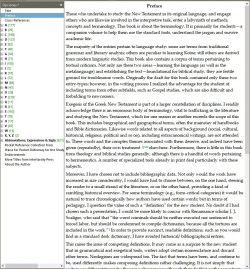The Theological Dictionary of the New Testament in 10 volumes by Gerhard Kittel & Gerhard Friedrich, translated into the English by Geoffrey Bromiley, is considered the standard Greek dictionary for Greek Bible study. Here’s my take, which should surprise nobody: it is the Best of Class when it comes to Greek dictionaries. I recommend you read my DDT Comprehensive Review for more information about the content of the module. This particular review is about how the module itself works with theWord Bible Software.
TDNT10 is designed to beautifully work with theWord. Let’s take a look at a few of the benefits of this theWord module. All of my following comments will be based on the entry for “justifed” found at Rom 3:24. I used the KJV English Bible module and the TRa Greek Bible module –
Take a look at the screen shot (those screen shots expland when you put your mouse on them). I’ve highlighted 3 areas (“A”, “B”, and “C”) for short discussion.
First, take a note of the slider (“A”). Notice how small it is? That means this particular article is loooong. How long, you ask? How about 25,000+ words!
Second, notice the topic tree (“B”). There are multiple items of interest I’d like to point out about this section. First, notice that the main roots are at the top. Yet also notice that each of those individual words has its own subentries below. How that practically functions is that this is one loooong article, but each entry is “clickable.” So by clicking any of those words in the root family, you can go straight to the proper paragraph. Nice. In our example, when I clicked on dikaioumenoi in the TRa module, it took me not only to the correct root stem, but right to the correct word (notice how it is shaded in gray). Nicer nicer! Oh, but get this, non-
Third, the real world book page entries are very subtly noted in every article.  Check out “C” and screen shot 2. This is important for two reasons. First, if you are writing an academic paper, this allows you to provide for easy citations in your work, because you know both volume and page number. But secondly, it allows you to reference other people’s footnotes.
Check out “C” and screen shot 2. This is important for two reasons. First, if you are writing an academic paper, this allows you to provide for easy citations in your work, because you know both volume and page number. But secondly, it allows you to reference other people’s footnotes.
Let me explain that. Let’s say you’re reading a work by Aloiscius Jones called Greek Widgets in the World of the Bible (if you can’t tell, I made that up). He makes a cool comment that you’ve never thought about before, and the only citation he makes to it is “see Kittel, Vol 8, page 275.” What? No word entry? How do I find that using theWord’s version? There are no digital page numbers!! Wait a minute: yes there are. And you can look it up! Using a book search window, simply type this in “v8 p275” and then search the TDNT10 topic content. Want to guess how many entries it will find? Just one. And from there, one click takes you straight to that content.
This module works just like I would expect a Greek dictionary to work with good Bible study software, and it has the added benefit of print-
This is simply a summarized review of the Theological Dictionary of the New Testament (10 Vols) as formatted for theWord, a free Bible software program.
This TW summary review is by Dr. David S. Thomason. Copyright 2023. All rights reserved.
——Book Review———————————————————————————————–
Theological Dictionary of the New Testament, 10 Vols (TDNT)
edited by Gerhard Kittel, Gerhard Friedrich, and Geoffrey Bromiley
a book review by “DoctorDaveT”
********
DDT Fast Facts
Rating: “Best of Class” Award – this work is in a class all by itself!
- German Liberal Rationalism
- Favored Scripture Version: Nestle-Aland Text
- Often abbreviated as TDNT or TDNT10
- An English translation from the original German
- 10 Volumes; 9,200+ pages; 2,300+ significant entries
- Originally published 1933-1973
- available digitally from $200; in hardcover, where available, starting at $300
- Entry Length: Verbose
- Theological Bias: Leans Left
- Academic Target: Pastoral-Theologian
- Language Skills Needed: Greek Helpful
********
Introductory Comments
The original Theologisches Wörterbuch zum Neuen Testament (if you don’t read German, that’s “Theological Wordbook of the New Testament”) goes way back into the early part of the Twentieth Century. It was originally published in Germany (in German, of course) in 9 volumes, from 1933 to 1973. (More on that under “Theological Bias.”) Originally published as a 9 volume set, when translated into English from 1964 through 1973 a tenth index volume was added in 1977. So sometimes you may see this abbreviated as “TDNT10.” For consistency sake, I’ll simply use “TNDT” in this review.
The set explores word meaning based on historical usage; not just in the Bible, but in the historical culture around NT times. Descriptives for this set include words like “monumental,” “massive,” “exhaustive,” (technically not exhaustive, but still) etc. When I tell you no stones were left unturned in the historical research into the background usage of these words, believe me, I’m not kidding.
The set quickly became the accepted academic standard for Greek word study. It still is.
Theological Bias
Everybody has a bias. It’s not possible to not have one. I, your reviewer, have one. (I’m a conservative evangelical.) The question “What is it’s theological bias?” should be asked when approaching any biblical work. It becomes absolutely essential when considering a theological work. And remember: the first “T” in “TDNT” stands for “theological.” I’m not saying I wouldn’t use a work that I disagree with (after all, I like this one – and it’s bias is very different from mine); I’m saying I want to know what an author believes before I read what he writes. Philosophy filtered through the Bible becomes truth or error. It’s as simple as that.
There is a decided bias throughout this work: German liberal rationalism. (If that just frightened you, make sure you keep reading.)
The man most responsible for this work is Gerhard Kittel. He was a German liberal rationalist. He was educated and taught at Tübingen – a notoriously academic but liberal German religious university. Nothing conservative comes from Tübingen. It gets worse: Kittel joined the Nazi party in 1933, and his writings were influential with Hitler. Kittel’s theological writings were used to support Nazi anti-Semitism. At the end of WWII, he was tried for war crimes and went to prison.
Kittel alone was not responsible for TDNT. Not only did he utilize dozens of contributors (nearly all of the same liberal persuasion), he himself died with only the first 4 volumes complete. He convinced a young intellectual, Gerhard Friedrich, to take over and finish the job. He reluctantly agreed. By the end of the work, there were over 100 contributors to the project; and again, liberalism is pervasive throughout.
Geoffrey Bromiley was the man brought in to translate from German into English. While not from Tübingen, he did teach at Fuller Theological Seminary (also not known as a hotbed of conservatism). Bromiley was one of the most influential theologians of the twentieth century; not so much for his original contributions, but because he translated so many German liberal rationalistic works into English. Reading the titles of what he translated is like reading a “Who’s Who” of German rationalistic liberals. Can he be different? The apple doesn’t fall far from the tree….
So – all these scholars associated with TDNT are theological liberals. Does that make their TDNT worthless? Hardly! Their “pitfalls” can become “rich mine shafts” if you understand and utilize their philosophical liberalism. Here’s how:
German Rationalism denied the inspiration of Scriptures. Instead, they were maniacal (think German engineering) in their pursuit of “original source material.” Their word studies are ultimately performed in an attempt to find original source material. Of course that original source material doesn’t exist (shh! don’t tell them! they’ll cry!); however, what they’ve left in their pursuit is a tremendous amount of background material to understanding the words in God’s verbally inspired Bible. Those words were not written in a vacuum; they were written by people that (the words, not the men) were inspired by God, and used by a culture with personal and cultural meanings. Understanding the background simply allows us to have a greater understanding of what God said.
TDNT stands for Theological Dictionary of the New Testament. It’s important to understand that the theology of TDNT is liberal; but the word studies themselves in TDNT are solid gold. If you’ll get your theology elsewhere, and use TDNT for word studies only, your Bible study will be enriched! By the way: even the editor recognizes this truth! Check out this quote from the editor’s First Preface:
“It need hardly be said that the translation and publication of Kittel is no necessary endorsement of everything contained in it. Written by many scholars over a long period, Kittel naturally contains articles of unequal value and varying outlook. Indeed, there are internal disagreements as regards basic presuppositions, historical assumptions and specific interpretations.”
Academic Target
The original size, scope, and cost of TDNT placed it as a title for the professional academician. However, in today’s world, if you are using a digital version, the size is immaterial, and the cost has come down significantly compared to what the set cost in 1980 (when indexed and compared to inflation). From a financial perspective, this entire set is comparable to the one volume “A Greek-English Lexicon of the New Testament and Other Early Christian Literature, 3rd Edition” (otherwise abbreviated lovingly as “BDAG”).
But then there is the scope. And wow! What a scope! 9,200+ pages, with 2,300 entries, spread out over 10 volumes. On average that is four pages per entry. And just about every word in your Greek New Testament is treated. While technically not exhaustive, comprehensive doesn’t do it justice.
To Kittel’s credit, he thought his work pastoral. Check out this quote from his first preface:
“If… it should not only advance research but also help the pastor in his study of Holy Scripture and pulpit ministry, this would be the finest reward that could be given us.”
Why is that? Because it was written not just theologically, but with exposition in mind. Here’s another quote from the first editor’s preface:
“While it is not a simple lexicon, it obviously cannot replace either the full commentary or the biblical theology. Its task is to mediate between ordinary lexicography and the specific task of exposition….”
As an expositor, that is music to my ears! However, having been intimately familiar with pastoral ministry and ministers for three decades, I can tell you that not all of us would appreciate the scope of a work like this. Therefore I’ve placed it squarely in between Pastoral & Theologian, knowing full well that there are pastors who would profit from it, but never open it.
Language Skills Needed
TDNT utilizes Greek language for the Greek words. The result will make this cumbersome for those unfamiliar with the Greek language. However, with a little bit of effort – and proficient usage of Volume X, an index – there is enough low hanging fruit that most mature Bible students can utilize it. For those with no Greek language knowledge, though, this work is probably a hard pass. Good News, though! The One Volume Abridged Version is much easier to use, and requires no Greek language skills to do so.
Entries
Length
Again, there are 2,300+ unique Greek word entries in this work. My highly scientific method (I randomly sampled 5 articles) gave me an average of 22,000 words per entry. One article was nearly 56,000 words (!!); another wasn’t 6,000. It would be hard to imagine longer entries for any word treated in this work.
Formatting
TDNT is not perfect. First, there is no numbering system utilized. (Why not use Strong’s? I don’t get it. It had existed for more than 30 years at that point. Was it because it was keyed to the TR and the KJV?) Second, while finding root words isn’t too difficult, finding the derivatives can be difficult for those with little/no knowledge of the Greek language. Fortunately Bromiley included Volume X as an index. While not making up for other issues, the index does help mitigate formatting problems.
Good News! Many/most/all software versions of TDNT make TDNT a cinch to use. Simply click on the Greek word from the NT text, and the TDNT entry will immediately appear. The computer version will be much easier to use than the hardcover. (Do I even need to say that?) For those with little Greek knowledge, a digital version will make all the difference for study usage.
Two Important Comparisons
I feel it necessary to compare TDNT with two other popular & important Greek works: TDNTa, & BDAG (these works were cited above in this article; don’t skip reading it; go back up and read it all; why are you still here?!).
As much as I want to, I’m going to ignore the historical, cultural, and theological similarities between TDNT, TDNTa, and BDAG. Here is the question I want to explore: if you only purchase one of these titles, which should it be? That answer could be another blog post as long as this one! But let me cut to the chase, for those interested in, well, chasing the answer! (By the way – the chase is a difficult one for this reviewer.)
From a pastoral perspective, if I only had one, it would be BDAG. Its exhaustive use defines every word in it’s biblical context, and it does so in just one volume. Short & sweet, yet it still allows me to grapple with the text.
From a cost perspective, the TDNTa is the clear winner. 85% less $$$ than BDAG and TDNT, and the comparative study results for each are close enough for horseshoes and hand grenades?! Really! Financially that’s a no-brainer!
From a Greek perspective, the TDNT is – hands down – the runaway victor. Kittel, Friedrich & Bromiley have literally said it all in these 10 volumes. So for the cost of a BDAG, and 10x the content of TDNTa, yeah, the TDNT is very much the most comprehensive work on the language of the Greek New Testament available anywhere in the universe! Over the top? Probably not….
Conclusion
If you are able to work past the theological liberalism and simply utilize this work for what it does best – analyze the use and evolution of Greek words throughout ancient history – this is everyone’s magnus opus.

